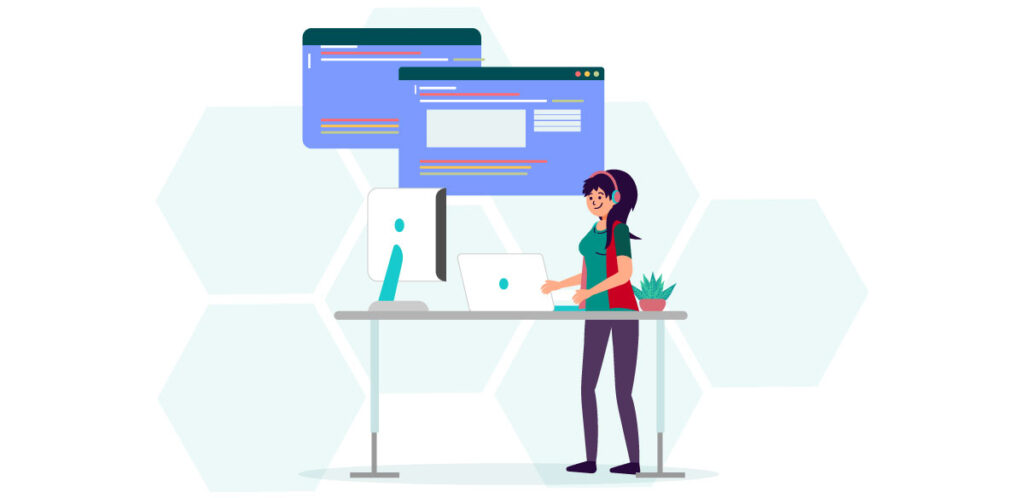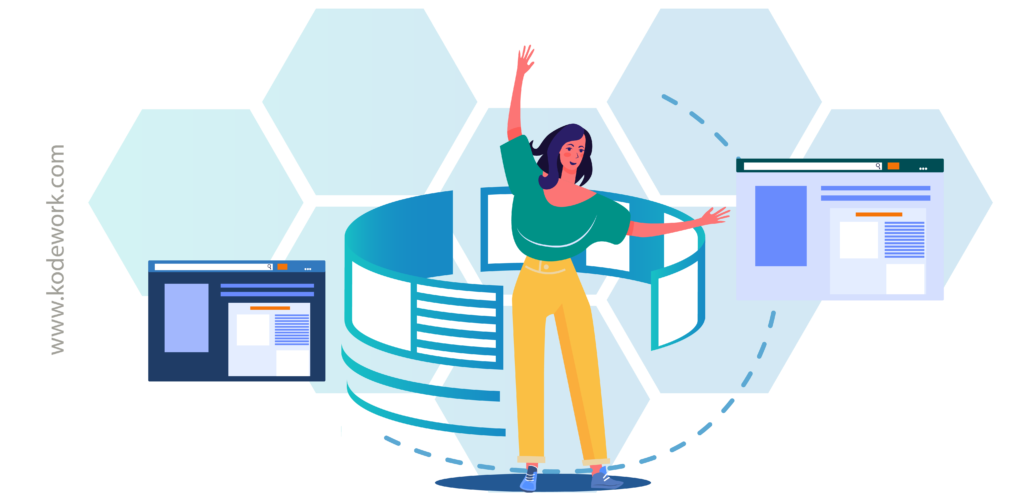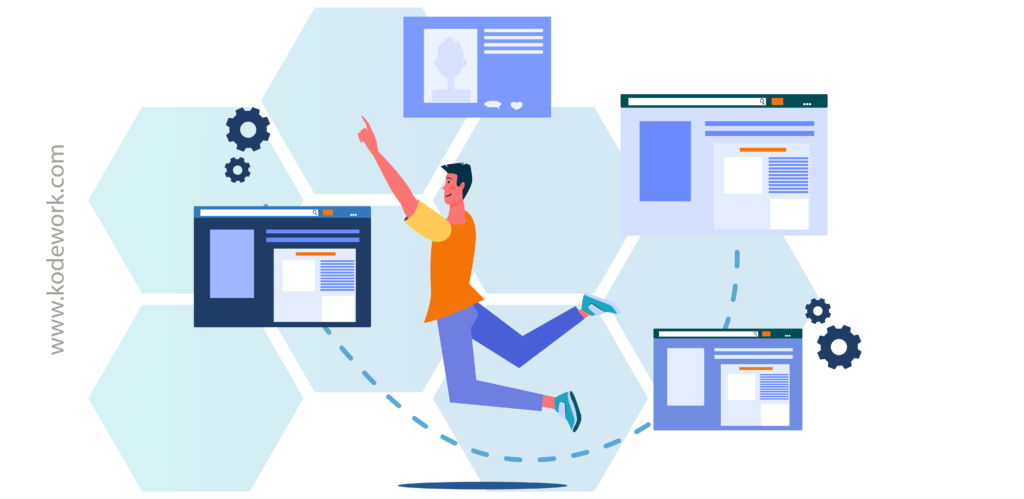Introduction
The Internet is a necessity. It powers our connectivity, accessibility and visibility. Nearly 5 billion internet users are connected to the internet. This means that if your website or app isn’t online, you are missing out obvious business growth.
Setting up a successful website over the internet needs expertise not just in web design but also in web development. And who better understands web development, than a web developer. Our web development guide will systematically discuss each component of web development. From the sketch of a web developer, to the different web development types, we will discuss them all. We will break the complex web development jargon into easy-to-understand pieces of information. Let’s get right into it.
Looking for a smart re-branded website design to attract more leads? What about user-friendly mobile app design? Call +91 750 620 3013 or write to [email protected], for getting in touch with our team of experienced web developers in Norway or India. Kodework works for clients all around the world. We pride ourselves in providing seamless web design and web development solutions. Whether you are a beginner or an expert, this guide benefits everyone.
Who is a web developer?
A web developer is basically a builder. Just like how a builder or contractor takes a blueprint and constructs a house, a web developer takes a web design and turns it into a web product. Instead of laying brick and mortar, a web developer writes complex lines of code (in a variety of languages). This could be for a dynamic website, eCommerce web stores (Shopify, Magento) or custom web development (CMS, Drupal, Umbraco, WordPress).
The language is dependent on how the server/system can understand it better. A developer communicates with the system in languages that is not English. The language must obviously be in command setting language because a developer is commanding the system to create a website or web design as per his/her liking.
Common programming languages are HTML and Python. We will get to the programming language types in just a bit. Setting this communication obviously requires time and skill. Different developers specialize in specific languages. Some understand multiple languages.
What are the types of web developers?
Unfortunately, this is not a straightforward question to answer. Each developer specializes in a programming language he/she prefers. Quite simply, web developers can be differentiated into Front-end, Back-end, and Full-stack developers.
The front-facing aspects of a website (which the user sees and interacts with) is handled by Front-end developers. The aspects that a user does not see, such as codes, containers, and functions, are handled by back-end developers. Full-stack developers mostly know a bit of everything.
How to become a web developer?
The most obvious way to become a web developer is by doing research and learning programming languages. Most online courses do provide the required material, but lack in direction. That is why it is important for aspiring web developers to do a bit of research before deciding which languages to devote time to.
Ask peers or colleagues as to which languages are in demand and are scalable. Then, set goals as to the completion of your development study goals.
The following websites provide beginner web development courses.
What are the different types of web development?
Although we will list down the most common web development types, we will discuss the two most important – Front-end and back-end web development.
Each web development type corresponds to a web developer of that particular framework. For e.g. a front-end developer works on front-end development.
Full-stack development
Full-stack development entails the development of both server and client sides of the web application. Complete websites or web applications are designed through interaction between backend, frontend, and database (Dynamodb, Mongodb).
Middle-tier development
Here, non-UI (user interface) codes are run on a browser. It simply is the plumbing of a web system. It is rare for a developer to be middle-tier. He/she is not specialized in either back-end or front-end but knows both bits.
Desktop development
Desktop development involves working with software applications. These applications run natively on operating systems such as Windows, Mac OS or Linux.
With Turbo C, Turbo Pascal, Quick C, Visual Basic, Delphi and Visual Studio, this development type was quite common during the 80s. Desktop developers use Graphic User Interface (GUI) tools such as XAML, WinForms, Gtk and Cocoa among others.
Mobile development
Mobile development includes the writing of code for mobile applications. These applications run natively over tablets and smartphones.
Thanks to the boom in smartphone usage in recent times, mobile development cannot be ignored. A mobile developer must understand the complexities of the mobile OS. Understanding development frameworks and environments for Android and iOS is key. It also includes Objective-C, Swift and Java.
Graphic development
Graphic development involves writing software codes specifically for shadowing, culling, shading, rendering etc. These are graphic design subsets which aid in improving graphic design software. Graphic developers work with frameworks such as OpenGL, Unity 3D, WebGL, DirectX etc. More advanced graphic development requires Assembly, C and C++.
Game development
Game development involves writing software codes for designing games. Game developers gain experience by working on interactive game design. The frameworks included here are OpenGL, DirectX, WebGL, and Unity 3D. The languages requisite for game development are Java, C, and C++.
Since Adobe Flash was abandoned, HTML5 and JavaScript has become the standard. Java and Swift are the choice of technology for Android or iOS games.
Data development
Data development refers to writing software programs that analyse data sets. Data developers see their skillset being used in machine learning, predictive modelling, and data visualization. The languages that a data developer needs to know are Python. R and SQL (PostgreSQL).
A big data developer is someone who writes software programs for large data systems. Relational database, data lakes management, and ETL (Extract Transform Load) are examples of large software programs. Some of the frameworks that a data developer works with are Java, R, Python, SQL, etc. They work on data management systems such as, Hadoop, Spark, and MapReduce.
DevOps development
DevOps include system developments for building, deployment, integration and administration. The technologies adopted by DevOps engineers are Docker, Apache Mesos, Terraform, Vagrant, Vault, Packer, Jenkins and Nomad.
CRM development
CRM development specializes in systems that collect consumer or user data. These developers work on improving sales and customer satisfaction for account managers and sales representatives.
Salesforce, SAP, ERP (Enterprise Resource Planning), and SharePoint are examples used by these developers.
Embedded Development
Embedded development requires developers to work with hardware that isn’t classified as computers. Real-time systems, microcontrollers, consumer devices, serial data transmission, electronic devices, hardware drivers and iOT devices fall under embedded systems.
The languages an embedded developer must learn are C++, C, Java, or Assembly.
What is Front-end development?
Also known as client-side development, it specializes in the programming of user interfaces. The interfaces work on layouts and aesthetics. The code written by a front-end developer runs on a user/client’s web browser. The level of work here is high.
A front-end developer must understand human-machine interaction deeply. Add to that the design principles of computer science. The bulk of the work is working on cross-browser compatibility issues. It also involves tweaking certain details in visual presentation of the UI. The skills that front-end development requires are, designing user experience (UX), user interface, HTML, JavaScript and CSS.
Front-end development languages
Before we discuss the actual front-end development aspect, let’s look at the languages needed for communication.
So, the front-end deals with what a user sees on the browser. When a user clicks on a website link, the browser initiates communication with the server. It says,
“Hey Server, I need information on what this particular website contains. I want to see images, videos, text, links and the site navigation layout.”
The server obliges and communicates back all the website design parameters that are designed as per the specifications of the browser.
Now, in order to maintain a constant connection with the server, a browser runs some quick client-side scripts that allow the website pages to function normally. That is why a user can move within the website links, without the website loading every single time.
Today’s websites are evolving. Front-end development now incorporates videos, large-sized header images, responsive displays, adaptive displays, minimizing objects, mouse-over functions, etc. To accomplish these complex tasks, developers depend on front-end programming languages such as,
HTML5
‘Hypertext Markup Language5’ is the most recent iteration of the classic HTML coding language. It is supported on all major platforms (Firebase, Oracle) and browsers.
It is well suited for the presentation of web content. It is a popular option for mobile application development as well.
HTML5 is considered the mainstay in front-end design. The other languages are considered supplementary.
CSS
Cascading Style Sheets (CSS) is a language that is focussed on issues concerning web page designing. It gives programmers the foundation for the addition of visual aesthetics.
They can be adapted to any screen-size or OS. CSS is compatible with possibly all web browsers. Both CSS and HTML5 codes can be added through a DOM (Document Object Model). DOM is a language-neutral interface that enables programmers to change elements on a page.
JavaScript
JavaScript is no longer a novelty programming language. It’s function basically remains the same, with an increased focus on website usability. It is now a universally adopted front-end coding language. It is supported as a plug-in, freely available on modern browsers.
JavaScript allows developers to automate tasks such as adding interactive features and animation. There is talk of applying machine learning into JavaScript. This makes JavaScript a critical language to learn. When plugged with Node.JS, JavaScript can be used in backend development as well.
Ajax
Asynchronous JavaScript and XML (Ajax) expands on JavaScript functions. This isn’t a surprise as JavaScript is part of Ajax’s acronym.
Ajax’s strong point is that it allows updation or changes to a page without forcing a reload. It accomplishes this by keeping certain elements of the page separated from the rest of it. This makes Ajax the obvious choice for adding autofill or autocomplete fields into forms without forcing a hard refresh.
Front-end development
Front-end or client-side development is where users operate. Although it is less complex as compared to back-end development, it is no less important.
Good front-end development ensures the bounce rate (the ratio of the number of users visiting a website to the ones leaving) remains low. Front-end development ensures your webpages are accessible across all platforms. Front-end frameworks usually consist of a collection of standard code. This code is either written in JavaScript or CSS.
These provide easy enterprise solutions to element placement issues. Typography, interface components and browser compatibility issues are also taken care of.
The common client-side frameworks are ReactJS, Vue.js, AngularJS, JQuery, TypeScript, etc. Although certain frameworks are constant, technologies do refresh on the client-side programming side. A front-end developer must stay in-tune with technological changes. Blogs, communities, and courses are excellent resources to take help of. Some aspects of front-end development that are good to know are,
- Acquiring a domain name. This is key for a website to get an identity. Firstly, register a domain name. All it takes is a small fee. Several websites such as GoDaddy, BigRock, Hover, etc. provide hosting services, as well as a domain name for a year.
- Brainstorm possible domain names. Ensure it is relevant to your business and can easily be remembered. Extensions such as .com, .net, .io, .org all have a purpose. For example, .net is associated with networking websites.
- If you are self-hosting the website on a server, acquire a static IP (Internet Protocol) address. Maintain a server-control software, get a firewall reconfigured, and route it for hosting websites. Finish the process by routing traffic onto that server.
After hosting and domain name comes the writing of the webpages. Developers are aware of browser compatibility. Some browsers only run on a particular operating system. There are online services available that let you test browser compatibility.
Would Safari work on the PC you are testing? Try Browsershots.org to get a snapshot of the website before it goes live.
Kodework Tip: Always keep UX as the primary focus
Front-end is the deep study of user experience. Try creating easy-to-follow navigation, maintain a consistent style and clearly defined content hierarchy.
What is Back-end development?
Also known as server-side development, back-end development involves specializing in implementation, design, core logic, performance, and scalability. The primary goal is to run a software/system on machines in hindsight from the end-user. Back-end systems are quite complex, which is obviously not visible to the user.
Take Google.com as an example. All the user sees in the front-end is a white background with Google’s logo, a user account setting on top right, and a text box to start a search,
But it’s back-end is a massively complex world of crawlers, algorithms, data, and servers. A back-end developer works with programming languages such as C, C++, Java, Python, Perl, Go, Scala, etc. A back-end developer must always be plugged-in to data storage, database, logging, caching, and email systems.
Back-end development languages
If front-end development handles user-facing aspects or in-browser systems, then the rest falls on the broad shoulders of back-end development. Here is a fairly limited set of front-end coding languages. Back-end, however, has a wider selection.
JavaScript
JavaScript repeats itself on the back-end side as well. It leads the back-end development programming language list. It is a language that runs within the browser and is also executed by the browser. Node.js, for example, allows JavaScript to be run on the Chrome JS engine as a back-end web server.
This allows developers to code both in front-end and back-end in the same language.
Java
Everyone knows that Java is object-oriented. This means that developers use it to build self-contained objects and parts using commands. Java is also open-source. It is a server-side coding language that is perfect for high-traffic sites. Java is also scalable and fast. It requires minimal software maintenance.
Java’s development ecosystem is massive. It is also readable on possibly any device or platform. All this is courtesy the Java Virtual Machine (JVM).
SQL
SQL or Structured Query Language is up next. It is query-based (as the name suggests). This means that rather than asking the system to perform specific actions, it works on retrieving data.SQL is used for generating reports and updating data sets. It’s not exactly an all-purpose server-side language.
C#
C# is similar to Java. It is also object-oriented. This allows developers to define the exact operations that need to be applied to various data structures. Development in C# includes numerous programming features such as assembly versioning, multithreading, indexers, automatic garbage collection, and Windows integration.
C# lets users enjoy the robustness of efficient systems by being part of .Net web development framework.
Python
Python is one programming language that enjoys a devoted developer community. The support offered within this community makes it easy for new programmers to adapt. Python simplifies the back-end coding process. It offers intuitive solutions that make it stand out.
Python language is a versatile and extremely effective teaching tool for beginner developers.
PHP
PHP is used for scripting. Despite this, it fills into roles pertaining to programming languages. PHP runs in a specific predetermined event. PHP is added to the HTML code, which sets it apart from the HTML code (e.g. <?___?>).
PHP is used for a variety of tasks. This included exchanging cookies and collecting data. It is well-suited for command-line scripting and server-side scripting. PHP is compatible with all prominent operating systems.
Back-end development
When codes are being written or processed, it’s the back-end where all this occurs. The goal of back-end development is to
- Maintain a structured data integrity
- Ensure performance and scalability is achieved
- Build a secure system
The three essential components of back-end development are
- Database – It stores, organizes, and processes information making it accessible and retrievable.
- Server – It is simply the computer hardware and software. It powers the whole process of website and database. It sends, processes, and receives data requests. It also handles encryption and security tasks.
- Web Apps – Web-server applications help with interaction between front-end and back-end systems.
The above three work together to create a working foundation for users to interact with websites successfully. Developers rely on numerous frameworks to meet the above objectives. Frameworks are simply software solutions. They provide the required libraries and tools to simplify web development.
Standard web development tasks include,
- Communication between databases
- Establish core security protocols
- Format the output
- Route the intended URLs
Frameworks are highly recommended for server-side development. Some popular frameworks for backend developers are – Flask, Laravel, Phoenix, Express.js, etc.
Node.js is an open-source and free server framework that operates on JavaScript. It is also compatible with all major platforms. A system can handle multiple requests at once using Node.js. This allows Node.js to perform numerous functions such as collecting form data, adding it to the database, modifying that data, managing files, and generating the dynamic content.
Web server software that does a similar job to Node is Nginx, IIS, and Apache.
Back-end development depends on API (Application Program Interface). A programmer will write an application program to connect with an Operating System (who is using an API). It is simply a set of protocols, tools, and routines for building applications or software. The front-end makes API calls, with the back-end executing the backend code. This task creates a layer of abstraction between the web application and back-end. The front-end is only dependent on the backend for the end result i.e. execution of the code.
REST is the most popular back-end API platform. REST APIs also send or receive data using JSON (JavaScript Object Notation). Other notable APIs is Rails. REST is built on a collection of endpoints. These allow web developers to create, read, update, and delete data. It makes use of HTTP methods such as GET, POST, PUT, and DELETE. The most commonly used framework for documenting APIs is Swagger.
About Kodework
Kodework is a global leader in web development. Our team of experienced web developers work with clients from across Europe to simplify human-screen interactions. We pride ourselves on delivering seamless user interface design, user experience design, mobile UI design, dashboard design and web design.
When it comes to employing the best UI UX designers in the country, Kodework leads the way. We are the top company for career growth. For our clients, we deliver business growth & brand building via UX UI prototyping tools, design techniques, adopting the latest web development trends and turning web needs to successful case studies.
The Kodework web development blog covers topics, such as prototyping, usability, architecture, interaction, process, research, styles, news, trends, tips, strategies, successful case studies etc.
Kodework works with Nordic Intent, Creometric, Ninestack and Fathamster Studio to serve B2B, B2C and B2E customers’ needs.





